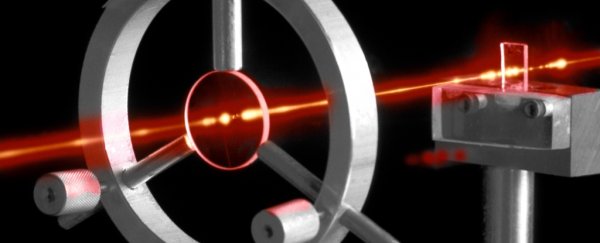Theoretically, it should be possible to turn light into matter. In practice, well - "easier said than done" is an understatement.
Now, 84 years after the process was first theorised, some researchers reckon they're going to be able to do it - and they're about to start the experiment.
It's called the Breit-Wheeler process, and it all has to do with E=mc2.
The process was first described in 1934, by a pair of physicists named Gregory Breit and John A. Wheeler, in the journal Physical Review.
In their paper, Breit and Wheeler proposed that, if you smashed two photons - particles of light - together, the collision would result in a positron and an electron. You would have created matter out of light.
It's not an easy thing to do. In fact, Breit and Wheeler thought it would be impossible, noting that it would be "hopeless to try to observe the pair formation in laboratory experiments."
Recent scientists have been a bit more optimistic, but experimental set-ups required the addition of massive high-energy particles, and it's still never been observed in a laboratory - or out of one, for that matter.
It was in 2014 that researchers from Imperial College London devised their experiment, removing the need for those high-energy particles. And now they're finally running the experiment.
"This would be a pure demonstration of Einstein's famous equation that relates energy and mass: E=mc2, which tells us how much energy is produced when matter is turned to energy," explained senior researcher and professor of physics Steven Rose.
"What we are doing is the same but backwards: turning photon energy into mass, i.e. m=E/c2."
The experimental set-up, what the team call a photon-photon collider, is a new type of physics experiment, involving two extremely high-power laser beams.
One is about 1,000 times the energy of photons that produce visible light; the other is about 1,000,000 million times the energy of visible light photons.
These lasers will be used to create the photons that are going to be smashed together. Inside a target chamber, electrons are fired at a slab of gold to produce a beam of high-energy photons.
Next, a second high-energy laser is fired into a tiny gold tube called a hohlraum to create a thermal radiation field.
The photon beam is then directed through the hohlraum, and the photons from the two sources collide. If it works, the team will be able to detect charged positrons from those collisions.
But they will have to check the data extremely thoroughly to make sure that the positrons didn't originate from other background processes. But if it works, the experiment won't just be amazing for its own sake - it may help us understand the universe a little better.
"When Gregory Breit and John Wheeler first proposed the mechanism in 1934, they used the then new theory of the interaction between light and matter known as quantum electrodynamics," said researcher Stuart Mangles.
"Whereas every other fundamental prediction of QED has since been demonstrated experimentally, the 'two-photon Breit-Wheeler process' has never been seen."
"If we can demonstrate it now, we would be recreating a process that was important in the first 100 seconds of the universe and that is also seen in gamma ray bursts, which are the biggest explosions in the universe and one of physics' greatest unsolved mysteries."
It still might not work - but that's one of the wonderful things about science. Sometimes it's about smashing things together to create a glorious mess of it all, seeing what doesn't work, and doing it better next time.
We're eagerly awaiting the results. In the meantime, you can read more about the experiment in the team's 2014 paper, published in the journal Nature Photonics.
